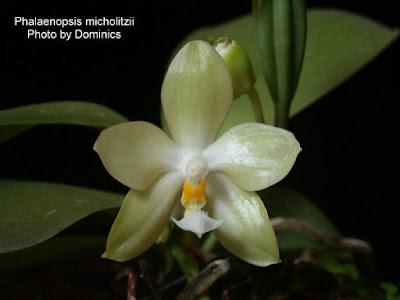Micholitz's Phalaenopsis is native to the Zamboanga peninsula in the island of Mindanao, and Luzon island, Philippines, on tree trunks or lianas near rivers at elevations of 50 to 900 meters, of subtropical or tropical moist lowland forests.
Phalaenopsis micholitzii orchid, also called as Micholitz's Phalaenopsis (named after the German orchid collector Micholitz), Polychilos micholitzii, is a species of the genus Phalaenopsis. This species was described by Rolfe in 1920.
IDENTIFY PHALAENOPSIS MICHOLITZII ORCHID
Micholitz's Phalaenopsis is native to the Zamboanga peninsula in the island of Mindanao, and Luzon island, Philippines, on tree trunks or lianas near rivers at elevations of 50 to 900 meters, of subtropical or tropical moist lowland forests.
It is a miniature sized, hot to warm growing epiphyte with fleshy, oblong to oblanceolate leaves. The leaves are 16 cm long and 6 cm wide.
Phalaenopsis micholitzii blooms in the summer on an axillary, short, 1 to 3 flowered inflorescence carrying fleshy, cupped flowers. The star-shaped flowers are 6-8 cm in diameter. They are spread out, have a delicate texture and open in turn. The flakes of both whorls are creamy-white to greenish-yellow and usually have a lighter center. One-colored flowers were taken with an orange-yellow thickening on the lip.
GROW AND CARE PHALAENOPSIS MICHOLITZII ORCHID
Cultural information should only be used as a guide, and should be to be adapted to suit you. Your physical location; where you grow your plants, how much time you have to devote to their care, and many other factors, will need to be taken into account. Only then can you decide on the cultural methods that best suit you and your plants.
Light:
Phalaenopsis micholitzii needs a light level of 8000-12000 lux and keep in partial shade.
Temperature:
The average temperature throughout the year is 29-35 ° C and 22-23 ° C at night, giving a daily difference of 6-13 ° C.
Humidity:
This plant need the humidity level of 80-85% throughout the year.
Substrate, growing media and repotting:
As a substrate, it is best to use a bark with a grain size of 12-16 mm with the addition of humectants, such as perlite, as well as charcoal to improve the air permeability of the substrate. Repotting is best done when the roots grow actively.
Watering:
Water about once a week and keep the plant fairly moist but not wet. It is recommended to use warm water at a temperature of about 21 ° C. Schedule of precipitation is wet / very wet.
Fertilizer:
It is recommended to apply a weekly or every two weeks 1/4-1 2 dose of fertilizer for orchids in the growing season.
Rest period:
The given cultivation conditions should be maintained throughout the year, and the plants always moist. Temperature fluctuations in winter are minimal. A higher level of light in winter can be beneficial.















COMMENTS